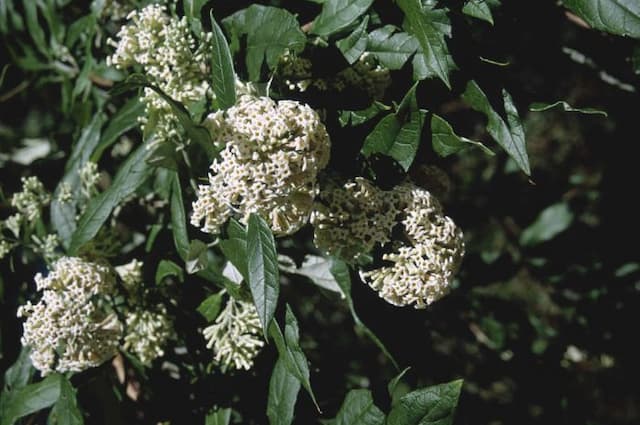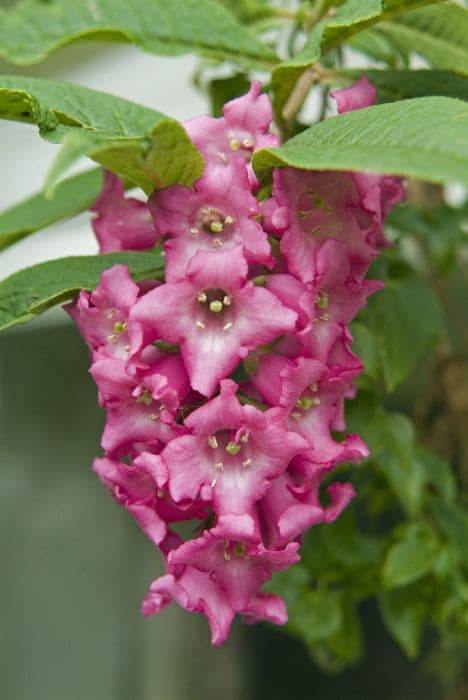Butterfly Bush Buddleja davidii Buzz Candy Pink = 'Tobudsopin' (Buzz Series)
ABOUT
The plant in question, commonly known as the Butterfly Bush, features an eye-catching display with a dense spread of voluminous flowers. Most striking are its candy pink blooms, which exhibit a conical shape and arrange themselves in clusters that seem to cascade, adding a touch of whimsy to the shrub. The flowers have a notably sweet fragrance that is known to attract butterflies and other pollinators, giving the plant its common name. The foliage of the Butterfly Bush is equally attractive, with elongated leaves that have a lush, green appearance, creating a backdrop that further accentuates the brightness of the flowers. The leaves also have a slightly fuzzy or soft texture, combining with the colorful blooms to create a multi-sensory experience in any garden or landscape. Overall, the appearance of the Butterfly Bush is one of vibrant color and lively energy, inviting onlookers to pause and enjoy its splendor.
About this plant
 Names
NamesSynonyms
Butterfly Bush, Summer Lilac, Orange Eye.
Common names
Buddleja 'Tobudsopin', Buddleia 'Tobudsopin'.
 Toxicity
ToxicityTo humans
Butterfly Bush (Buddleja davidii) is generally considered to be non-toxic to humans. There is no widespread documentation of poisoning from this plant, and it is commonly grown in gardens without reports of adverse effects from ingestion. However, as with many plants, individual sensitivities can vary, and it is always advised to avoid eating plants not known to be safe for consumption.
To pets
Butterfly Bush (Buddleja davidii) is not commonly known to be toxic to pets either. It is typically not listed among plants that are hazardous to dogs, cats, or other domestic animals. While it's always best to prevent pets from ingesting plants, there are no well-documented cases of poisoning from Butterfly Bush in pets. However, if a pet does consume a large quantity of any non-food plant, including Butterfly Bush, it may experience gastrointestinal discomfort or other issues simply due to the ingestion of non-digestible matter. If you suspect your pet is showing symptoms of illness after consuming any part of a plant, consult with a veterinarian.
 Characteristics
CharacteristicsLife cycle
Perennials
Foliage type
Deciduous
Color of leaves
Green
Flower color
Pink
Height
2-3 feet (60-90 cm)
Spread
2-3 feet (60-90 cm)
Plant type
Shrub
Hardiness zones
5-9
Native area
Asia
Benefits
 General Benefits
General Benefits- Compact Size: 'Tobudsopin' is smaller than other varieties, making it well-suited for small gardens or container planting.
- Attractive to Pollinators: The plant produces nectar-rich flowers that attract butterflies, bees, and other beneficial insects.
- Drought Tolerance: Once established, it is relatively drought tolerant, reducing the need for frequent watering.
- Long Blooming Period: The Butterfly Bush has a prolonged blooming season, offering repeated displays of its flowers from early summer to autumn.
- Easy to Grow: It is known for being easy to grow, requiring minimal maintenance, which is ideal for novice gardeners.
- Vibrant Color: The 'Tobudsopin' variety provides a vivid candy pink color that can brighten up any garden space.
- Fast Growing: The Butterfly Bush is relatively fast-growing, which allows gardeners to quickly achieve a mature and established look.
- Deer Resistant: It is generally resistant to deer, which is beneficial in areas where deer predation is a problem for garden plants.
 Medical Properties
Medical PropertiesThis plant is not used for medical purposes.
 Air-purifying Qualities
Air-purifying QualitiesThis plant is not specifically known for air purifying qualities.
 Other Uses
Other Uses- Butterfly Attractant: Butterfly Bush is widely recognized for its ability to attract butterflies, making it a favored choice for butterfly gardens and wildlife habitats.
- Natural Dye: The flowers of the Butterfly Bush can be used to produce a natural dye for fabrics or crafts, offering hues in varying shades of pink and purple.
- Aromatherapy: The fragrant flowers can be used in potpourri mixes or other aromatherapy products to create a calming and pleasant ambient scent in homes or workplaces.
- Erosion Control: Due to its fast growth and extensive root system, Butterfly Bush can help with erosion control on slopes or areas prone to soil erosion.
- Art and Craft: Dried branches and flowers of the plant can be incorporated into floral arrangements, wreaths or as part of decorative displays.
- Photography: With its vibrant pink blooms, Butterfly Bush can serve as a beautiful photography subject or as a natural backdrop for outdoor photo shoots.
- Privacy Screening: When planted in a row or a hedge, Butterfly Bush can create a living screen that provides privacy and blocks undesirable views.
- Educational Use: Schools and educational programs may use the plant in lessons about pollination, butterfly life cycles, or horticulture.
- Honey Production: When included in gardens and landscapes, these bushes can be significant nectar sources for honey bees and contribute to local honey production.
- Theme Gardens: Butterfly Bush is often incorporated into themed gardens, such as fairy gardens or other whimsical landscape designs, for its colorful and vibrant appearance.
Interesting Facts
 Feng Shui
Feng ShuiThe plant Butterfly Bush is not used in Feng Shui practice.
 Zodiac Sign Compitability
Zodiac Sign CompitabilityThe Butterfly Bush is not used in astrology practice.
 Plant Symbolism
Plant Symbolism- Renewal: The Buddleja, also known as Butterfly Bush, often symbolizes new beginnings and renewal due to its ability to attract butterflies, which are creatures representing transformation and growth.
- Attraction: Butterfly Bushes are well-known for attracting butterflies and other pollinators, hence they symbolize attraction and magnetism.
- Rebirth: In a similar vein to renewal, the plant's association with butterflies, which go through a dramatic metamorphosis, represents rebirth and change.
- Hope: The bright colors and sweet nectar of the Butterfly Bush can be a symbol of hope and optimism as it provides sustenance for butterflies and signifies the flourishing of life.
- Consolation: Because the Butterfly Bush is a resilient plant that can thrive in various conditions, it may symbolize solace and the ability to endure and find comfort during difficult times.
 Water
WaterThe Butterfly Bush should be watered deeply once a week, providing it with 1 to 1.5 gallons of water each time depending on the climate and soil drainage. During hot and dry periods, increase watering to twice a week to ensure the soil remains moist but not waterlogged. It's important to avoid overhead watering to reduce the risk of leaf spot diseases. Always check the top inch of soil for dryness before watering to prevent overwatering. During the winter months, reduce watering as the plant requires less moisture when it is dormant.
 Light
LightButterfly Bush thrives best in full sun, which means it should receive at least six to eight house of direct sunlight every day. It's essential to place it in a spot where daytime light is abundant and unobstructed. However, in extremely hot climates, a bit of afternoon shade can help protect the plant from intense heat.
 Temperature
TemperatureButterfly Bush is hardy and manages well in a temperature range from 20°F to over 90°F. The ideal temperature for optimal growth is between 60°F and 80°F. It can tolerate winter lows to 20°F, but mulch can be added to provide extra protection for the roots in colder zones.
 Pruning
PruningPruning the Butterfly Bush promotes healthy growth and abundant blooms. Prune in late winter or early spring before new growth begins, cutting back the previous year's growth to about one-third of its size. This helps to maintain its shape and encourages the growth of fresh, flowering shoots. Always remove any dead or diseased wood during pruning.
 Cleaning
CleaningAs needed
 Soil
SoilButterfly Bush (Buddleja davidii 'Buzz Candy Pink') prefers well-draining soil rich in organic matter with a pH range of 6.0 to 7.0. A good mix would be garden soil, compost, and perlite or sand to improve drainage. Mulching helps retain moisture and suppress weeds.
 Repotting
RepottingButterfly Bush typically doesn't require frequent repotting and can be done every 2-3 years or when it outgrows its current container. Ensure the new pot is only one size larger.
 Humidity & Misting
Humidity & MistingButterfly Bush is adaptable and does not require specific humidity levels. It thrives in average outdoor humidity and can tolerate different conditions.
 Suitable locations
Suitable locationsIndoor
Place in bright, direct sunlight; water moderately.
Outdoor
Plant in full sun, ensure well-drained soil, water regularly.
Hardiness zone
5-9 USDA
 Life cycle
Life cycleBuddleja davidii, commonly known as Butterfly Bush, begin their life cycle as seeds, which, when sown, germinate to produce seedlings. These seedlings establish a root system and shoot up, entering a vegetative stage where they develop leaves and stems. During the growing season, Butterfly Bushes may enter a phase of rapid growth, given adequate water, sunlight, and nutrients, eventually maturing into shrubs. As adults, they produce fragrant flowers in large conical clusters, usually blooming from mid-summer to fall, attracting butterflies and other pollinators. After pollination, the flowers produce small capsules filled with seeds. At the end of the growth season, the plants may become dormant, particularly in colder climates, until the next spring when the cycle begins anew.
 Propogation
PropogationPropogation time
Spring-Summer
Buddleja davidii, commonly known as Butterfly Bush, can be effectively propagated through semi-hardwood cuttings during summer. This method involves taking a cutting from a healthy parent plant, ideally about 4 to 6 inches (10 to 15 centimeters) long. The cutting should include at least a couple of leaf nodes and should be taken just below a node. Leaves on the lower half of the cutting are removed, and the raw end may be dipped in rooting hormone to stimulate root development. The cutting is then placed in a well-draining potting mix, ensuring that at least one node is below the surface. Adequate moisture and warmth are key, so maintaining a humid environment, such as using a plastic cover or propagator, can be beneficial for root growth. With proper care, the cutting will develop roots and can eventually be transplanted into the garden.

![Butterfly bush [Berries and Cream]](/_next/image?url=https%3A%2F%2Fplants-admin.emdemapps.com%2Fimages%2Fplants%2F%2Fimages%2F604b650f667be.png&w=640&q=75)





![Butterfly bush [Nanho Purple]](/_next/image?url=https%3A%2F%2Fplants-admin.emdemapps.com%2Fimages%2Fplants%2F%2Fimages%2F604b5e3cb2c58.png&w=640&q=75)

